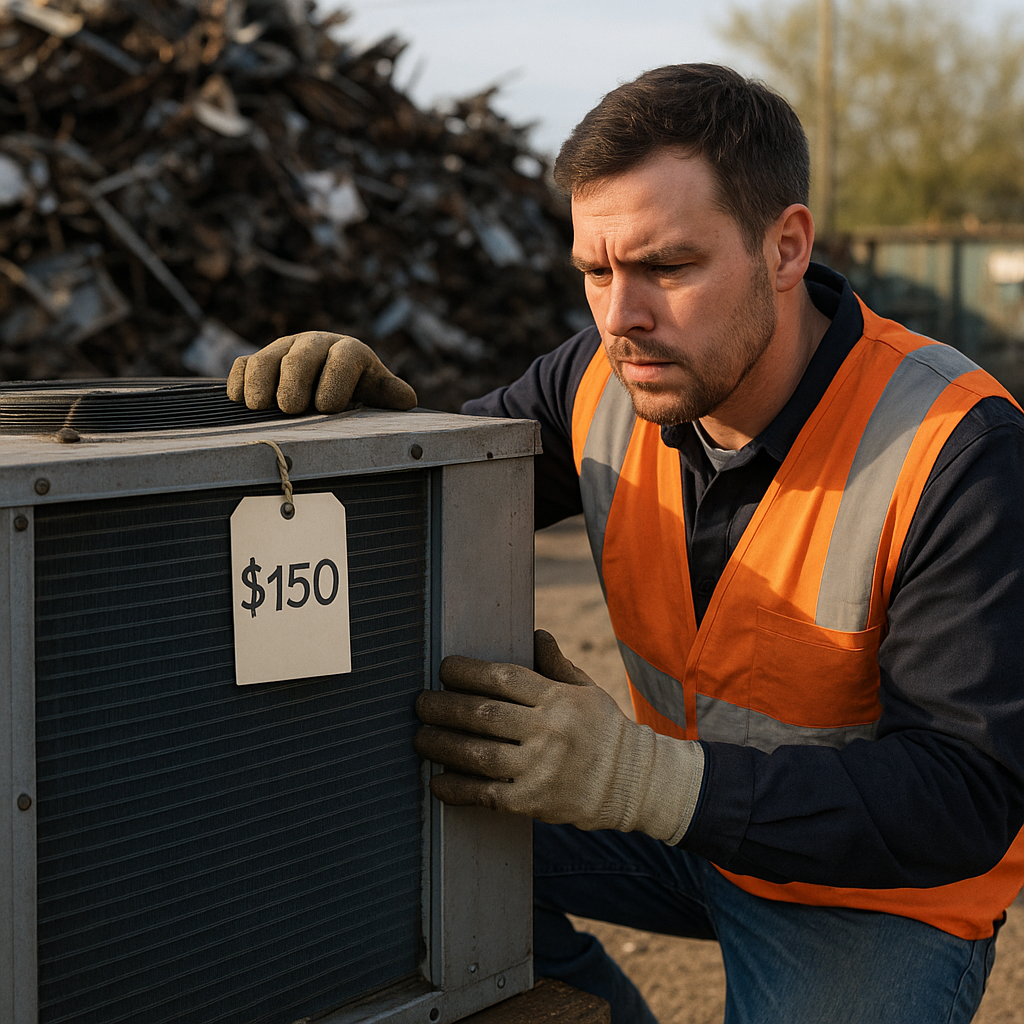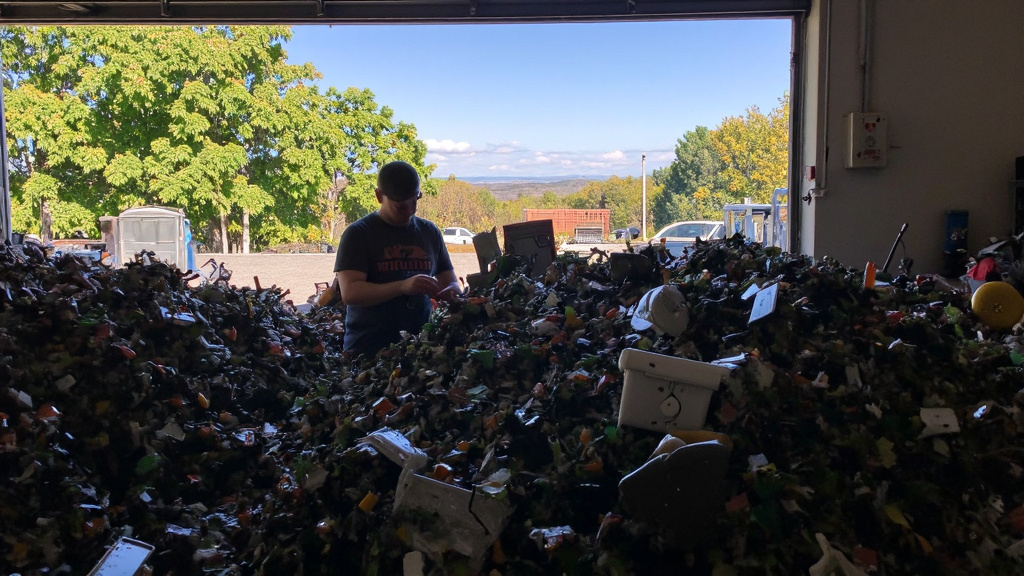5901 Botham Jean Blvd, Dallas, TX 75215
What Is the Scrap Value of Chillers?
May 9, 2025The demand for metals significantly influences the scrap value of chillers. Current prices for copper, aluminum, and steel directly affect the amount recyclers will pay for your equipment. These prices fluctuate based on global supply chains, manufacturing needs, and economic conditions.
Metal composition greatly impacts overall value. Chillers contain valuable metals including copper coils, aluminum components, and steel casings. Higher percentages of non-ferrous metals like copper and aluminum typically result in better payouts compared to units primarily made of steel.
The size and weight of the chiller affect both its intrinsic value and logistics costs. Larger units contain more recyclable material but require specialized equipment for removal. Some recyclers offer flat-rate pricing for intact units or higher rates if they can dismantle the equipment properly.
Refrigerant status impacts both handling requirements and value. Chillers containing refrigerants like R-22 require proper evacuation before recycling. Some recyclers may deduct costs for this service or offer less if refrigerant removal is needed.
The condition and age of the chiller can affect recovery rates. Older units might have more wear and corrosion, potentially decreasing the quality of recoverable metals. However, vintage equipment sometimes contains higher percentages of valuable metals than newer models.
Dismantling complexity influences processing costs. Chillers with easily accessible components allow for quicker separation of valuable materials. Complex units requiring significant labor to break down may command lower prices despite containing valuable metals.
Transportation requirements can impact net returns. The location of your chiller and distance to recycling facilities affect logistics costs. Many scrap dealers offer pickup services but may adjust pricing based on accessibility and loading requirements.
Market timing can maximize returns. Metal prices fluctuate seasonally and with economic cycles. Some recyclers advise waiting for favorable market conditions when possible, especially for large volumes of scrap chillers.
Processing options also affect value realization. According to industry sources, giving recyclers a few days to properly dismantle chillers can increase returns by 20-40% compared to flat-rate pricing for intact units. This allows for proper separation and classification of various metal types.
Specialized components within chillers carry premium values. Brass fittings, copper piping, and aluminum-copper coils can be worth substantially more when separated than when processed as part of mixed scrap. Companies with appropriate equipment to extract these components offer better rates.
| Metal/Material | Current Price |
|---|---|
| Forklift Batteries | $0.15/lb |
| Chillers | CALL FOR PRICE |
| Scrap Generators | $0.04-$0.04/lb |
| Circuit Breakers | $0.04/lb |
| Steel | $100/GT |
| Light Iron | $100/GT |
| Cast Iron | $165/GT |
| Power Supplies (w/ wires) | $0.25/lb |
| Telecom Equipment | $0.10-$0.30/lb |
| Servers | $0.25-$0.45/lb |
| Back Panels | $2.00-$5.50/lb |
How Can You Get the Best Price for Scrapping Chillers?

Securing the best value for your industrial chillers requires strategic planning and market insight. Scrap metal prices fluctuate with market demand, material composition, and regional factors. Start by researching current rates.
Contact multiple scrap yards for quotes before deciding. Different facilities offer varying prices based on their specialization and equipment. Specialized recyclers like Rockaway Recycling handle large industrial equipment and may provide more competitive rates than general scrap yards.
Understanding your chiller’s components is crucial for maximizing value. Industrial chillers contain valuable metals such as copper and aluminum coils, brass fittings, and copper pipes. These components fetch different prices when sorted properly.
Preparation Makes a Difference
Proper dismantling significantly increases your scrap value. When chillers are broken down into components, you can often earn 20-40% more than scrapping the unit intact. This process separates higher-value metals from lower-value materials.
Clean your materials before bringing them to the yard. Remove non-metal components like plastic, rubber, or wood attachments. Clean scrap prevents contamination and typically commands better prices.
For copper wires commonly found in chillers, consider stripping the insulation. Bare copper generally brings substantially higher prices than insulated wire. Wire stripping tools make this process more efficient.
Timing and Transport Considerations
Market timing matters when scrapping industrial equipment. Metal prices fluctuate seasonally and with global economic trends. Some recyclers publish their current prices online or through apps, helping you track the best time to sell.
Transport logistics affect your bottom line. Some specialized recyclers offer pickup services for large industrial equipment, potentially saving you significant transportation costs. Ask about this option when requesting quotes.
Get everything in writing before proceeding with any transaction. Request certificates of destruction if needed for compliance purposes. Some facilities can also handle proper fluid drainage, which is essential for environmental compliance.
Additional Value-Maximizing Strategies
Consider the payment structure offered by different yards. Some provide immediate payment, while others might offer higher rates if they can take time to dismantle the equipment themselves. Weigh these options based on your timeline and priorities.
Keep detailed records of your transactions for potential tax benefits. Business owners may qualify for certain recycling-related deductions or credits depending on local regulations.
| Component | Role | Relative Value |
|---|---|---|
| Compressor | Increases refrigerant pressure, essential for cooling | High |
| Condenser | Transforms gas to liquid, releases heat | Medium to High |
| Evaporator | Absorbs heat, initiates cooling cycle | Medium |
| Expansion Valve | Regulates refrigerant flow and pressure | Low to Medium |
| Copper Coils | Conducts refrigerant, aids in heat exchange | High |
| Aluminum Components | Structural and thermal roles | Medium |
| Steel Casings | Encloses and protects internal components | Low |
Finally, develop relationships with reputable scrap yards in your area. Regular customers sometimes receive preferential pricing or first access to higher rate opportunities. A trusted relationship can translate to more consistent returns over time.
What Are the Environmental Benefits of Scrapping Chillers?

Metal recycling from scrapped chillers plays a crucial role in resource conservation. By recycling these industrial cooling units, we recover valuable metals that can be reused in manufacturing new equipment, significantly reducing the need for raw material extraction through mining.
The environmental impact of recycling extends beyond material conservation. The energy required to process recycled metals is substantially lower than that needed to mine and refine virgin materials. This energy reduction translates to decreased greenhouse gas emissions and a smaller carbon footprint.
Resource Conservation Through Metal Recovery
Chillers contain significant amounts of recyclable materials, particularly metals like copper, aluminum, and steel. Recovering these materials through proper scrapping prevents them from ending up in landfills. Instead, they reenter the production cycle as valuable resources.
The conservation benefits are substantial when considering the environmental cost of metal extraction. Mining disrupts ecosystems, consumes vast amounts of water, and often releases pollutants. Every pound of metal recycled means less mining is necessary.
By supporting chiller recycling, organizations contribute to a circular economy where materials maintain their value and utility rather than becoming waste. This approach helps preserve natural resources for future generations while reducing present-day environmental degradation.
Proper Handling of Potentially Harmful Components
Chillers often contain refrigerants that can harm the environment if released improperly. These substances, particularly older refrigerants, may contribute to ozone depletion and global warming if they escape into the atmosphere. Professional recycling ensures these chemicals are captured and handled according to regulations.
Beyond refrigerants, chillers may contain other components requiring specialized disposal methods. Oils, electrical components, and certain insulation materials all need proper management to prevent environmental contamination. Professional recycling facilities have the expertise to safely remove and process these materials.
Environmental protection extends to groundwater and soil quality. Without proper handling, hazardous materials from discarded chillers could leach into soil and water systems. Responsible recycling eliminates this risk by ensuring all potentially harmful substances are contained and processed appropriately.
| Benefit | Description |
| Energy Conservation | Recycling reduces the need for new raw material extraction, saving energy. |
| Landfill Waste Reduction | Recycling chillers significantly reduces landfill waste. |
| Resource Preservation | Conserves raw materials like steel and copper by recycling existing components. |
| Environmental Protection | Prevents harmful substances from contaminating the environment. |
| Economic Value | Recovered materials can offset disposal costs and generate revenue. |
Reduced Water Usage and Pollution Prevention
The environmental benefits of chiller recycling include significant water conservation. Mining for virgin metals is extremely water-intensive. By recycling metals from chillers, we help reduce the demand for these water-consuming processes.
Pollution prevention is another key benefit of proper chiller disposal. When chillers are scrapped responsibly, we eliminate the risk of refrigerant leaks and contamination from improper disposal. This protection extends to air, water, and soil quality in communities surrounding disposal sites.
The comprehensive environmental advantages of proper chiller recycling make it essential for sustainable industrial practices. Beyond regulatory compliance, this approach demonstrates environmental stewardship and commitment to sustainability goals that increasingly matter to stakeholders and communities.
Conclusion: Maximizing the Value of Your Scrap Chillers

Recognizing the scrap value of chillers provides both financial and environmental advantages. These industrial units contain valuable metals like copper, aluminum, and stainless steel, which can be recycled into reusable materials. By researching current market conditions, staying informed about metal prices, and collaborating with specialized scrap yards offering competitive pricing, you can make informed decisions that maximize returns while supporting resource conservation.
Interested in converting your end-of-life chillers into value? Contact Okon Recycling at 214-717-4083 for expert assistance with your industrial recycling needs. Our team specializes in extracting maximum value from commercial HVAC equipment while ensuring environmentally responsible disposal practices.
